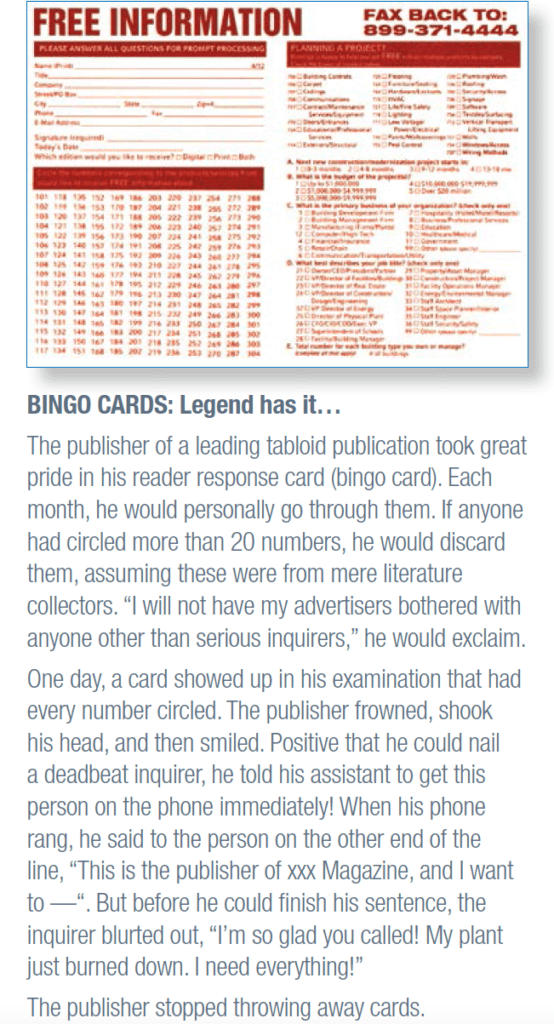What Are Advertisers Buying?
Disappearing audits and reader service cards, questionable e-circulation counts, and an overall lack of accountability on both the media outlet and advertiser sides are keeping the B2B market in the dark in terms of what is being bought and sold. It is time for advertisers to take responsibility and demand accountability for what they are buying from the outlets, and more importantly, from themselves.
Preface
This white paper is not an indictment of print advertising. We love print advertising. It is an indictment of a process gone bad and getting worse. We receive more than 1,000 magazines each month in our offices. One of those is Vogue. Its March 2017 issue has 517 pages with a four-page gatefold cover. You might ask: What does Vogue have to do with advertising in business-to-business (B2B) publications? Our answer would be twofold: “Nothing. And, everything!”
Vogue is doing what B2B publications used to do: They are maintaining their relationship (affinity) with their readers. They make a promise to people who receive their magazine, and they keep it.
Vogue also has a robust website, which does things the print magazine either doesn’t do or can’t do. And, the print magazine does something very important the website can’t do: exist outside an electronic portal (try unfolding a four-page insert on a computer!). Print magazines offer a visual and tactile experience an electronic channel cannot deliver.
And it’s not just Vogue. Magazines aren’t going anywhere. Each month, we receive new ones, and some of the older ones stop coming in. The age we live in is volatile, and there is disruption going on. But amid all of this turmoil, the thirst for information is greater than it has ever been.
B2B magazines’ proposition used to be clear: They would provide a targeted audience that advertisers could access for a fee — by purchasing ad space. That proposition, as we will demonstrate, has been corroded for many reasons. Media outlets have lost their grip on their controlled audiences and opened up access to anyone who wants it, thus nullifying their core proposition. The Internet has helped shape this corrosion and confused advertisers. Our white paper — based on meetings and relationships with magazine publishers, media companies, advertisers and their representatives — attempts to help you sort it out.
Overview
For the past 20 years, Accountability Information Management Inc. (AIM), a business-to-business (B2B) research company in Palatine, Illinois, has researched many topics. But the subject area that AIM has studied most completely and from a number of different angles has been the media outlets that support the B2B marketplace, and more pointedly, the effectiveness of advertising running in print and electronic media.
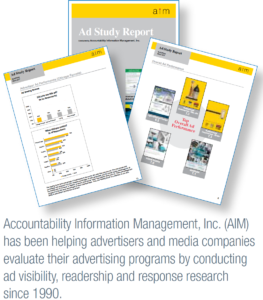 Since the publication of its original article in MARKETING RESEARCH magazine in 1990, “Behind the Numbers,” where we argued about the relationship between seeing and reading scores to inquiries, AIM’s research into advertising behavior has been in a unique position. AIM has conducted numerous publication-sponsored research projects into circulations and inquiries, as well as independent, third-party studies relating to advertising including: Reach and impact studies, how readers prefer to receive information, and what specifiers and decision-makers do with the information.
Since the publication of its original article in MARKETING RESEARCH magazine in 1990, “Behind the Numbers,” where we argued about the relationship between seeing and reading scores to inquiries, AIM’s research into advertising behavior has been in a unique position. AIM has conducted numerous publication-sponsored research projects into circulations and inquiries, as well as independent, third-party studies relating to advertising including: Reach and impact studies, how readers prefer to receive information, and what specifiers and decision-makers do with the information.
Over the years, AIM has built a database of seeing and reading scores in excess of 1 million impressions in a variety of markets. These measurements, compiled by independent auditing research companies such as Starch and Harvey, produced a benchmark against which AIM was — and still is — able to identify what we call “creative factors” in advertising to generate increased awareness and response.
Today, not only does AIM catalog and analyze independent readership studies, AIM conducts online ad and editorial readership studies for publishers. Our ad readership studies collect information on an ad’s visibility and engagement by the audience and also provides advertisers with verbatim feedback on the reader’s interest and reaction to the ad.
AIM is affiliated with a leading advertising and marketing communications organization in the B2B field. Interline Creative Group Inc., which also supports the sales and marketing efforts of B2B companies that use advertising, as well as working relationships with many publications in a variety of fields, is also a valued resource.
But our world is changing.
Perhaps better said, the way information is distributed and received is changing, and that includes advertising. That means what is and is not advertising is changing. These changes are profound and irreversible. They impact entire industries, devastating some and creating entirely new ones nearly overnight (e.g., Pinterest, Snapchat, Instagram, Chatbots).
Therefore, a study of these changes in the flow of information will affect media and media purchasing. In 2016, Google’s ad revenue was $79.4B1. Compare that to newspapers, whose global spending on newspaper print ads is expected to decline 8.7% to $52.6 billion in 2016.2
The reason this is important is because Google directly impacts what digital content is consumed and distributed, which affects advertising per se. If 70% of people go to Google first in their search for information, the requirement to be on page one (either by organic SEO or paid Google words) becomes imperative. It doesn’t, however, discount print or other forms of advertising; it just reshapes it. People are getting their information from multiple sources these days (we’ve become a multi-screen society, and print is actually a “screen”).
This disruption has a profound effect on what people define as “advertising.”
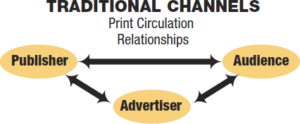 Disruption has spelled disaster — and opportunity — for B2B publishers and media companies who have traditionally relied on the model of having a clearly defined audience offered to advertisers, an audience that was verified yearly so that advertisers knew they were reaching “the right” people. This “reach” was critical in the B2B channel, which is often characterized by many influencers who can, at any moment, disrupt the sale of the product. In the past, B2B publishers identified an audience, gathered it around their brand, and then offered advertisers a chance to reach these qualified people through advertising.
Disruption has spelled disaster — and opportunity — for B2B publishers and media companies who have traditionally relied on the model of having a clearly defined audience offered to advertisers, an audience that was verified yearly so that advertisers knew they were reaching “the right” people. This “reach” was critical in the B2B channel, which is often characterized by many influencers who can, at any moment, disrupt the sale of the product. In the past, B2B publishers identified an audience, gathered it around their brand, and then offered advertisers a chance to reach these qualified people through advertising.
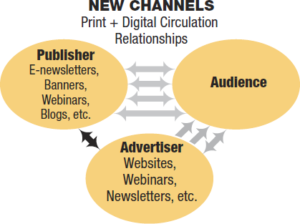 When the Internet emerged, media companies moved quickly to that channel, seeing the opportunity to save a lot of money by offering both print and digital advertising opportunities. This further splintered the connection between the advertiser — publisher audience. It is difficult to know as media buyers exactly what we are buying in B2B and what is at the heart of the changes media buyers face.
When the Internet emerged, media companies moved quickly to that channel, seeing the opportunity to save a lot of money by offering both print and digital advertising opportunities. This further splintered the connection between the advertiser — publisher audience. It is difficult to know as media buyers exactly what we are buying in B2B and what is at the heart of the changes media buyers face.
Why we are so unsure of what we’re buying in media today is the essence of this white paper. We’ll uncover why some of these questions remain unanswered. Our contention is this: Ultimately, only the advertisers — not the publishers or content providers — will be able to truly answer what they’re buying anymore.
Take P&G
Procter & Gamble is the biggest advertising spender in the world. In a recent article in WSJ, Marc Pritchard, chief brand officer and marketing lead for P&G, admitted that they have no idea of the value they are getting with advertising. Pritchard complained earlier at the Interactive Advertising Bureau’s (IAB) Annual Leadership Meeting about “complexities in the digital ad business, confusing agency contracts and the need for more widespread adoption of an MRC ad viewability standard.”3
“We don’t want to waste time and money on a crappy media supply chain,” Pritchard added.
And they are not alone. According to Digiday, the threat of disappearing ad revenues from ad blocking makes publishers and advertisers alike shudder. Some say it could cost the industry between $16 billion and $35 billion by 2020.4
Who Is Their Audience, and How Can You Tell?
Most publishers claim that their print publication is still their premier asset — which is not surprising given the higher revenues that print vehicles generate versus digital properties and print’s long-standing reputation.
However, sales reps no longer spend much time in their media sales presentations substantiating the quality and composition of their circulations, which are the foundation of the print product. When asked specific questions about their circulations, some reps do not always have answers and even display ignorance about publication auditing methodologies that support circulation figures.
Let’s be clear: The audience reach that magazines provide through their circulation is what publishers sell (or did sell). Advertising in print provides access to that segment of people in one or more markets who can specify, recommend or purchase advertisers’ products or services. If they cannot document these people, what are advertisers purchasing?
Our internal debate over the “why” of these sales demonstrations revolves between simple ignorance and the impact of the digital revolution. We reject ignorance, because in many cases, the reps we work with are seasoned professionals who have been in the industry for many years. Their knowledge (or knowledge we believed they once possessed) somehow vaporized. And while we can point the finger at digital’s effects on the marketplace, we cannot blame digital entirely for reps’ poor demonstration of knowledge. There’s something else afoot.
AIM believes that most publishers in recent years have been focusing more on their digital products and less on their circulations. They are changing with the times, largely because they have to. However, their changing doesn’t satisfy the thirst for information from their audiences. In fact, their audiences find information in places outside those “normal” channels, which causes the disruption and actually increases it.
In the past, a B2B media outlet actually had an exclusive on an audience. The publisher spent the majority of his expense finding and qualifying that audience, making an advertiser trying to reach it very happy: simply place an ad, and you do so.
Today, however, that audience does not participate in this exclusive relationship. In fact, even after qualification by a third party like BPA®, there’s no guarantee that the audience is even consuming the content provided by the publisher. This disconnect is what causes advertisers to question what the advertising investment actually buys.
Digitally, it’s worse. Programmatic advertising with its algorithms is what we call “lazy advertising.” According to an IAB report entitled “The Outlook for Data 2017: A Snapshot Into the Evolving Role of Audience Insight,” there were “ongoing problems associated with the measurement and attribution of data.” In other words, they can’t measure anything. Furthermore, the study cited that despite lingering measurement issues, the panelists of experts said their organizations were going to increase their spending on data and related services. Does that make sense to you?
Early in our business, we worked with many engineering companies, and one of them said something profound about electricity: “If you can measure it, you can control it.” The problem today with advertising is that you can’t measure it, and therefore, you can’t control it. This is a huge disconnect, and something that can, as we argue in this paper, only be solved by the advertiser. In this “age of the customer,” where the customer is in control of the deal, it is the “age of the advertiser” where the advertiser must be in control of the deal. The time and money publishers previously spent qualifying and cleaning their circulations, therefore, have either been abandoned or redirected to other areas of revenue generation. By refocusing from their core differentiation — the circulation — they have freed their audience to go elsewhere for information. In other words, the audience is pulling the strings, not the publishers.
Why Circulation Matters
AIM’s internal media analysis shows the percentage of circulation at B2B publications that are one-year qualified has vanished. A one-year qualification means that the magazine is annually contacting every reader to check whether those readers are still interested in receiving the publication and to update their contact information. The higher the percentage of one-year qualified circulation, the better for the advertiser from a return-on-investment point of view.
In the 1990s, reps touted their qualified circulations; “one-year qualified” was the gold standard of readership list management. Savvy advertising agencies and media buyers shunned a publication if its circulation had a sizeable percentage of two-or three-year qualified names.
 Today, a number of publications show three-year qualified names without even an explanation, which indicates that the readers are only being contacted every three years. Plus, some publishers apparently don’t think anything of presenting these names as the “new normal”. In fact, reps often say until they met with us, they were never asked to show an audited circulation statement.
Today, a number of publications show three-year qualified names without even an explanation, which indicates that the readers are only being contacted every three years. Plus, some publishers apparently don’t think anything of presenting these names as the “new normal”. In fact, reps often say until they met with us, they were never asked to show an audited circulation statement.
How valid is a list that hasn’t been maintained in three years? And then there is the question of saturation. Sending a magazine once a month to a qualified audience is very different than bombarding an e-mail file several times a week. According to Mashable, we send more than 200 million e-mails every minute. Also:
- 2 million terabytes of data are created every day, of which about 10% is structured data.
- Every 48 hrs we generate as much data as from the beginning of time to 2000.
It is no wonder that according to WSJ, more than half of all digital advertising is now mobile.
Between company mergers/acquisitions, layoffs, personnel moves and more, how many people do you expect will still be at the same job at the same address and phone number after one year, much less three years? According to the U.S. Postal Service, a mailing list atrophies at the rate of 1% every week. Imagine how much atrophy sets in after three years! If advertisers are buying ad space in a magazine or a digital network based on a rapidly aging list, what are they really buying?
Besides, what media outlet has everyone you want to reach? We had a client recently that wanted to reach a specific market through print advertising. There is no single publication that can do that; even if you purchase two or more of the main ones in that market, you’d be hard pressed to say you “cover the market.”
For example, architecture is a licensed function, so if you are going to practice in a state, you have to carry a license. In one click, we can download all 11,656 architects in the state of Texas. One publication delivers to 2,620 in Texas. Another 6,064. In either case, we’re not even close to reaching “architects in Texas” if we simply use print.
And before you believe that you can reach all 11,656 even IF you had their e-mails, think again. The amount of e-mail that goes unopened is staggering. According to MailChimp, one of the world’s leading email marketing platforms used by 15 million customers, open rates for emails across all industries are around 27%. That’s based on a study they did over hundreds of millions of e-mails delivered by their system.5 Of the 112.5 billion marketing e-mails sent worldwide in 2015, this means 30.4 billion were opened and about 82.1 billion unread and unopened.
It’s Not That Easy Anymore
Because of the digital disruption, everyone is a publisher and by definition, everyone will have a circulation – a collection of individuals who receive your content distribution. When you send someone or some group an e-mail, you “circulate” your content. They, in turn, can re-distribute your content. Information, thus, travels over many channels on the digital highways, and the control of that distribution is what is behind all of the commotion going on in publishing.
This is why the industry has changed words like “controlled circulation” to view, or “inventory” of views. Views become the digital currency of content on a digital platform – the same “views” that were and are the seeing scores of traditional print advertising.
Prior to the electronic revolution, reps and media outlets emphasized the quality of their circulations in their media sales presentations. With a BPA statement in hand, the rep would take the time to explain the composition of their audience and the importance of their circulation audits that supported their readership claims. Reps largely understood how their circulations were refreshed using ins/outs (number of qualified readers added and subtracted during an audit period), and they knew how their circulation compared to the competition.
Today, that’s no longer the case – with anyone. This is why it is up to the advertiser – MORE than anyone else – to understand what they are purchasing when they purchase print or digital media.
The sales discussion has shifted from a focus on quality circulation to frazzle-dazzle presentations to promote cutting-edge or ancillary offerings such as videos on demand, webinars, electronic banners, e-newsletters, social media sites, trade show sponsorships, and other spin-offs from their flagship properties. In one presentation, no matter what the representative presented, when we asked the price, it was $25,000. Sponsorship of a webinar? $25,000. Co-sponsoring an event, including running some advertising in the magazines? $25,000. Incredible.
Advertisers have stopped demanding proof that a publication or service is reaching the desired or targeted audience. Advertisers seem to be no longer interested in that information. Why?
Incredibly, some reps are as confused when asked whether their audience is audited! Among those who can answer that question, many can not answer more advanced questions about what particular figures on their own magazines’ audit statement mean, nor can they explain the basics of auditing processes. This demonstrates to us the monumental shift in how sales reps are positioning and selling their properties, as well as in what advertisers are asking for. This disconnect, we believe, is at the core of the fundamental change going on in media purchasing today.
Frankly, audited statements are also moving toward irrelevance. After all, if no one asks for them, relevance disappears.
Audit versus Publisher Statements
From the media outlet’s perspective, perhaps it’s largely a matter of cost: Paying for a full audit to be conducted by a third-party company like BPA or ABC is pricey especially if no one uses it. This may be why some publishers cut corners by simply issuing a Publisher’s Statement. (And, if no one asks for audited circulation statement, why SHOULD they spend the money?).
A publisher’s statement, however, is very different than a formal audit. It’s like saying, “I am an honest person. Trust my numbers” as opposed to having a trusted, independent source attest, “Yes, that person is honest, and the information is accurate.” Point of view is everything, especially in auditing.
An audited statement is backed by a third-party verification of the circulation’s validity. Think of these organizations as the publication equivalent of bank auditors. Media companies pay third-party audit companies like BPA or ABC for their auditing services. This entails conducting an independent review of the magazine’s circulation. The audit company does not simply take the word of their media outlet client that they reach who they say they do and that the quality of their audience is good. Audit companies verify whether the circulation is what the publication claims it to be.
There are at least four audit companies doing work today. BPA and Alliance for Audited Media (formerly Audit Bureau of Circulations) are the largest.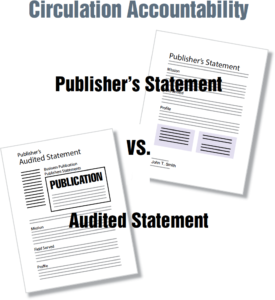
- BPA Worldwide. BPA Worldwide is in the business of providing assurance. For 80+ years as a not-for-profit assurance service provider, BPA was originally created by advertisers, advertising agencies and the media industry to provide third-party magazine audits and verified audience data used in the buying and selling of advertising. Performing nearly 2,600 audits in over 30 countries, BPA is a trusted resource for compliance and assurance services across print, electronic, social and trade show media.
- Alliance for Audited Media. This organization is a recognized leader in cross-media verification with unparalleled expertise across all brand platforms including web, mobile, e-mail and print. More than 4,000 publishers, advertisers, agencies and technology vendors depend on their data-driven insights, technology certification audits and information services to transact with trust.
- Circulation Verification Council (CVC) is an independent, third-party reporting audit company. CVC audits thousands of editions nationwide with a combined circulation of more than 55 million.
- Verified Audit Circulation. This growing company has been providing recognized and trusted circulation auditing and research services to the publishing industry for 60 years. Verified has become a reputable brand, providing exceptional accuracy, integrity, and personal services tailored to media providers and buyers.
Anyone can go to the websites to see the audits; some, like the AAM, charge for the service. Others, like VAC, you simply click, or BPA, you just register. The question is, how many advertisers do this? The question is also, how many advertising buyers care?
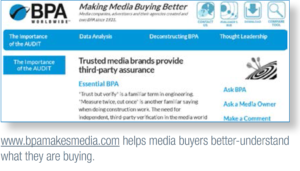 We Work for BPA
We Work for BPA
Two years ago, we conducted research over the phone with more than 25 companies, including publishers, agencies and advertisers. The results were eye-opening, and without disclosing proprietary information, it confirmed much of what we knew already as a company: education of what people buy is lacking. In fact, we created http://www.bpamakesmedia.com/, which is a comprehensive micro-site that explains not only how to read statements, but presents white papers and other resources to help buyers of media better understand what they are buying.
There are many publications that have not been audited for more than two consecutive cycles — neither in the previous June or December, which is when audit statements are typically issued. Some publications have done away with audited circulation statements entirely. What they offer as a confirmation of circulation is simply a receipt from the U.S. Post Office, indicating how many magazines were mailed in one particular month.
Does a postal receipt prove the quality of circulation? A receipt from the post office offers absolutely no accountability regarding to whom those magazines are mailed. Without an audit or some other proof of a particular circulation, how can advertisers be sure the audience seeing and reading their ads are the people they want to reach?
If a magazine can fill its pages with ads — and the publisher manages to do this without an audit statement — why bother doing an audit at all? But then, if advertisers don’t ask for proof of what they are buying, why should the media outlets do more? More important, how long can that go on without proof or ROI knowledge?
Furthermore, in this age of information, how accurate is accurate? When the era of Big Data was born, there was a lot of hoopla about how it was the greatest thing ever. We’d no longer have to think; big data would do it all for us. You would be able to target, mark, re-target, cultivate to your heart’s – and your bottom line’s – content.
This is part of what is disrupting the auditing process: people move too fast, and there are programs that can (in theory at least) track a person wherever they go from media outlet to media outlet. Before you swallow that drink, however, think about a myth.
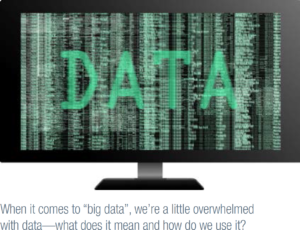 Myths exist for reasons. Like fairy tales, or other stories, a myth helps us to explain what was going on around us when there isn’t any science. There are always shreds of truth within the myth because they are based on some kind of reality. Lately, there’s a chill in the air when the topic of Big Data comes up or promises that algorithms and programmatic buying are going to solve all our problems. That’s because there were a lot of myths created around it that are now being dispelled. Reality is setting in. Here is a taste.
Myths exist for reasons. Like fairy tales, or other stories, a myth helps us to explain what was going on around us when there isn’t any science. There are always shreds of truth within the myth because they are based on some kind of reality. Lately, there’s a chill in the air when the topic of Big Data comes up or promises that algorithms and programmatic buying are going to solve all our problems. That’s because there were a lot of myths created around it that are now being dispelled. Reality is setting in. Here is a taste.
- Big Data was never meant to be a Wizard of Oz-like man behind a curtain, says Patrick Gray.6 During the 2013 holiday shopping season, many of the big data analytical tools employed by retailers failed to predict consumer behavior. And, just look at the last election in the U.S.!
- Prakash Nanduri7 said in 2014, Big Data will lose its luster. This top CEO of Paxata says we need to admit that big data—up to this point—has been best suited for needle-in-the-haystack analytics, as opposed to something that everyone benefits from.
- It will be years before Big Data’s usefulness is fully realized says eMarketer.8
- Deloitte invites you to join the debate on whether listening to Big Data can help with your strategy.9
When it comes to data, we’re all a little overwhelmed. Anyone who has started down the data trail knows that it’s impossible to ever have enough. We have a saying in our company: “The more you look, the more you see; the more you see, the better you know where to look.” But with data, you inevitably keep seeing more. And wanting more. That’s the nature of data.
The reality is there is only so much data you really need to draw conclusions. Nate Silver, in his book The Signal and The Noise, says collect as much information as possible, but then be as rigorous and disciplined as possible when analyzing it. It’s the “as possible” that’s the question. Today many media outlets try to track and validate readership and response. Publishers are always looking at other ways to substantiate their e-media audience, such as measuring how “engaged” its readers are compared to other magazines.
Audience engagement speaks to how invested readers are in a publication in terms of how much time they spend reading and clicking through various sections of its website (including electronic ads and sponsorships, of course), which is a way of showing how much its readers care about the property and value it offers. But “engagement” has nothing to do with “who” is engaged! If I do not specify or buy your product, what good is engagement?
Third-party audits have strengths and weaknesses. The jury is still out, however, on whether other analytical services or tools can provide as thorough and objective a review of a media vehicle’s audience, or if there is value in demonstrating audience engagement relative to a solid verification of readership.
Clearly, between the costs of conducting audience/circulation audits and advertisers’ dwindling interest in the verification these audits offer, media companies are becoming bolder about looking into other auditing methodologies to assure and validate their audience or dropping audits altogether.
Tracking Audience Inquiries
Up until a few years ago, most B2B publications bound a reader service card, or “bingo” card, in each issue. Each ad would have an inquiry number printed at the bottom that would correspond with the number on the card. Readers could circle the numbers to receive more information from the advertiser. The publisher would forward these inquiries to the advertiser, proudly asserting that it was this publication that was responsible for generating these valuable sales leads.
Unfortunately, the reader service card is almost extinct. Without the reader service card, advertisers are forced to track ad effectiveness in other ways. Or, they often opt out of tracking print altogether. They may, for instance, promote a unique website (e.g. using a suffix on their regular URL that is coded to a particular publication or campaign) or phone number on their ads so they can see which publication drove in the inquirer. If an advertiser does not code the ads, or if readers reach the company through a regular website URL or phone number, it becomes more difficult to track ad effectiveness. Advertisers frequently ask us how they can provide their management with ROI on their advertising budget. With no way to track or measure any type of audience engagement or inquiry to a particular ad or marketing channel how can true ROI be measured?
QR codes, which readers can scan with their smartphones, is a technology that links the target audience to company websites, Facebook page,Twitter or other social media sites. QR codes are a way to track the audiences’ interest in your product as well as promote a deeper connection with the audience by engaging in social media or offering a call to action.
 Today QR Codes can be customized and personalized to enhance any B2B marketing program.
Today QR Codes can be customized and personalized to enhance any B2B marketing program.
These codes give advertisers a way to measure individual magazine response—just like a reader service card, with the exception of not knowing “who” is hitting the QR. For example an advertiser running in 26 different publications can economically create 26 different QR codes, and then track the response from the 26 magazines very effectively. To find out more about “who” is hitting the QR code, a savvy advertiser might try reaching out to the media provider to see if they can append additional audience data to the QR code lead. When they were first introduced, everyone hopped on the QR bandwagon. Today, you only rarely see them. But that doesn’t detract from their effectiveness (i.e., packaging is incorporating the codes as a way to connect the consumer to specific information about the product they just purchased).
As a replacement for inserting a “bingo” card, some publishers run a list of advertisers in the magazine and then invite readers to go to the magazine’s website to request information from manufacturers. If readers prefer receiving information via websites, why would they go to a publication website rather than directly to the advertiser’s website? This is an unnecessary extra step.
To avoid the cost of binding printed reader service cards into their publications, some other publishers have opted for online reader service cards. AIM’s experience has found that online cards produce very few inquiries. Sometimes, the only metrics the electronic reader service card can provide advertisers is how many people “clicked” on the advertiser’s website.
Other publications have discontinued any type of inquiry generation activity on behalf of their advertisers. This puts inquiry tracking squarely on the advertisers’ shoulders, AND they’re left with fewer ways to hold media companies accountable as effective advertising vehicles. It’s up to advertisers to build metrics into their ads, websites or digital media.
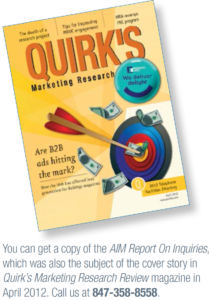 So why do some publishers prefer to step out of the inquiry generation game altogether?
So why do some publishers prefer to step out of the inquiry generation game altogether?
Removal of the reader service cards and failure to provide alternative inquiry-tracking mechanisms eliminate an important way to measure the value of magazines. More and more, there is little discussion on any publisher-sponsored market research that demonstrates that their audience looks at or reads advertising in their publications or buys/specifies particular products. Advertisers need to require media companies to provide key stats on how the publisher’s audience receives and responds to their advertising message.
In addition to the elimination of inquiries as a way to measure an ad’s success, AIM’s analysis of various clients’ ad programs shows that many publications no longer offer ad readership studies. While these ad studies don’t necessarily provide all the answers on the success of a given ad, they do offer a form of accountability. It is unfortunate, and it is another indication of the profound change going on, that such studies are being dropped. Without inquiries to measure the draw of an ad to evaluate the quality of the publication’s audience, or no ad readership research to uncover who saw or read an ad, how can advertisers hold a publication accountable?
Electronic Media: What is Behind the Numbers?
By all accounts, the B2B media market is moving more toward digital offerings. A third-party study of 100 manufacturers that was commissioned by a publisher, reported that companies overall spend 2%-5% of their sales dollars on marketing, and most of the money goes into the development of their website or other electronic media.
In February 2017, a CMO Survey published and sponsored by Deloitte, Duke Fuqua School of Business, and the American Marketing Association provides valuable insight on marketing executives electronic media budgets. In determining the percent change in traditional advertising versus digital marketing spend in the next 12 months, participants reported that their digital spend would increase almost 15%, while traditional a modest 1%. But in B2B, projections for spend in traditional were -1%, and digital 13%. Interestingly, in their spend on analytics, a +376% growth in spending over current levels was projected – to 22% of their budget. In other words, they are spending relatively more in digital, but spending mostly to figure out what they are spending it on. What’s wrong with that picture?
The problem, of course, is fraud. White Ops, Inc. and the Association of National Advertisers produced a paper called “The Bot Baseline: Fraud in Digital Advertising.” This was done in 2014, and fraud’s impact has only increased. For example, the paper pointed out that Global advertisers will lose $6.3 billion to bots in 2015. As stunning as this is, weigh that against advertisers’ rush to increase their digital spend; it’s as if they have to make up for the waste by spending more!
The problem is perpetuated by lists that people rent and use. Hidden in these lists are the bots, who play havoc when distribution takes place.
It is interesting how quickly advertisers flocked to digital media, with little hard proof that it provides their products/services with the exposure and response they seek from their target audiences. As pointed out, the market is still trying to determine how to measure and what to measure when it comes to electronic media!
While every rep and media outlet push their electronic products — web banners, videos, e-newsletters, blogs, webinars, microsites, Twitter, Facebook — they offer relatively limited information and accountability for these media outlets.
In the infancy of electronic media, even proof that an e-ad campaign ran as promised could not be provided: Reps had no electronic equivalent to printed tear sheets that magazines send for ads that run in their printed magazines. Sometimes, Interline clients are sent links to their e-media buys, but they still have to take the word of the publications on some aspects of their electronic purchases.
In fact, many will not present the impressions, open rates, click-throughs or unique visitors without being asked. When asked how the average advertiser performs across the various media outlets, many indicate that the information is proprietary. If an advertiser has no basis for comparison, how do they know if their ad was a success or not?
So how can advertisers find accountability in electronic media? Do impression numbers they provide really tell you that the audience going to that digital product saw a particular ad or even read it? Or that it was the “right” audience? Are we to assume that if someone opens an e-mail that an impression is made for every advertiser?
Most media companies do not provide proof that readers see and read banners on their websites or their e-newsletter ads. What is behind that click-through from a banner ad? There is no proof that a person clicking on a given digital ad is even from the advertiser’s target audience. It could be from anyone on the web.
The Interactive Advertising Bureau (IAB) is one of the organizations that tries to determine metrics for all-things digital. In their 2016 “Desktop Display Impression Measurement Guidelines” – a 21 page document — they say the following:
“A Rendered Impression across all display marketing channels is the measurement of responses from an ad delivery system to an ad request from the user’s browser, which is filtered for invalid traffic and is recorded at a point as late as possible in the process of delivery of the creative material to the user’s browser. The ad must be loaded and at minimum begin to render in order to count it as a valid rendered impression.”
Majoring in English does nothing to help understanding what this means. Note, according to that definition, an “impression” has to first of all be rendered. Duh. Secondly, it is the measurement of “responses from an ad delivery system” to an “ad request” from the user’s browser. In other words, take the human being out of the equation. Impressions are a transaction between a browser and an ad delivery system. Have you ever heard of anything as ridiculous as this? And yet, this is the type of metric being used, discussed and quantified in discussions of advertising effectiveness.
John Wanamaker, the successful businessman, is credited with saying, “Half the money I spend on advertising is waste; the trouble is I don’t know which half.” Mr. Wanamaker today might say, “All of the money I spend on advertising is wasted; the trouble is, I can’t stop advertising.”
Because it is ADVERTISING that has changed, along with how it is distributed and created. Advertising itself is undergoing redefinition because of digital disruption, and unfortunately, things like “banners” or “towers” or whatever simply don’t fit anymore. If anything “native advertising” is more the trend, but that is a subject for another paper. Furthermore; IAB said this:
“A valid rendered impression may only be counted when an ad counter receives and responds to an HTTP request for a tracking asset from a client. The count must happen after the initiation of retrieval of underlying page content and only when ad content has been loaded and at minimum begins to render (see note on Tracked Ads below). Permissible implementation techniques include (but are not limited to) HTTP requests generated by <IMG>, <IFRAME>, or <SCRIPT SRC>. For client-side ad serving, the ad content itself could be treated as the tracking asset and the ad server itself could do the ad counting as long as counting does not occur until ad content has been loaded and at minimum begins to render.”
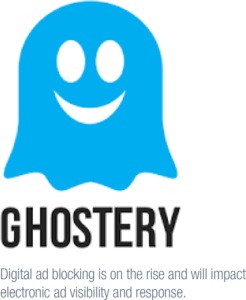 Wow. Really? And that means we’re more interested in the measurement – not the thing itself we’re measuring! What happened to measuring response, period? Digital is so complex because of technology, that arguments ensue as to “when” the ad is even seen.
Wow. Really? And that means we’re more interested in the measurement – not the thing itself we’re measuring! What happened to measuring response, period? Digital is so complex because of technology, that arguments ensue as to “when” the ad is even seen.
And, what about ad blockers? Though publishers may not like it, ad blocking appears to be on the rise, especially among the millennial generation.10
And furthermore, a study by Reuters Institute for the Study Of Journalism by the University of Oxford found:
“Business problems for many publishers have worsened with the rise of ad-blocking, which is running at between 10% (Japan) and 38% (Poland) but much higher amongst under-35s and people who use news the most. The vast majority of those who have ever downloaded a blocker are using them regularly, suggesting that once downloaded people rarely go back.”
Finally, Adobe produced “The Cost of Ad Blocking” report Wow. Really? And that means we’re more interested in the measurement – not the thing itself we’re measuring! What happened to measuring response, period? Digital is so complex because of technology, that arguments ensue as to “when” the ad is even seen.with stunning statistics, including:
- Globally, the number of people using ad blocking software grew by 41% year over year
- 16% of the US online population blocked ads during Q2 2015
It’s only going to increase.
Advertisers must begin to demand more accountability, but in reality, they can only demand it of themselves.
When stats are presented, there is typically no basis for comparison. Publishers don’t willingly provide advertisers with an overall average for electronic visibility or engagement. Advertisers must begin to demand publishers provide an overall average for ads/banners of the same size or for the same media, and they must investigate and develop methodologies within their own companies to identify, define and discover value of their ad efforts.
One prospect we were talking to, for example, said that their CRM software could not e-mail anyone unless they filled out a form from their website. This prospect was letting the CRM software platform dictate the terms of engagement; that is, the software was limiting their thinking. Our practice has always believed in bending the software to our desire for accountability. This is why more often than not, you have to utilize different pieces of software to identify and uncover the real value of what’s going on digitally or in print.
For example, a publisher might tout the “fact” that clicks on their e-newsletter have an 11 percentage point lead over the competition. AIM wonders how the publisher could even know what his competition’s e-newsletter yields, especially where the metrics for their own e-newsletter falls short of real proof. In challenging the reps, there is no clear answer! Do prospective advertisers hearing this type of pitch question the validity? They must to understand fully what’s going on.
What is the difference between sponsoring a newsletter to a publisher’s list, and sending your own newsletter to your own file? What benefits have you calculated by newsletter sponsorship? What if you “rented” a list or created a new list yourself and sent your own newsletter to that file? Such questions are essential to accountability. Demonstration of value is not an afterthought, though from the way digital advertising is being purchased one wonders that it comes up at all.
Today in addition to statistics on impressions and clicks, media companies provide more types of electronic stats – information on duration of user’s sessions, page duration and number of unique browsers. But these stats offer no real proof of the audience the electronic media reaches.
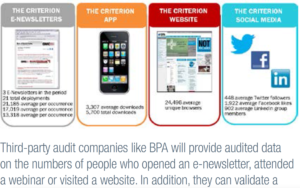 Third party audit companies have added some accountability to e-media by verifying the publisher stats on electronic media. Audit companies will validate the number of clicks, page duration, average webinar attendees, Twitter followers, Facebook likes, etc. But even with this type of audit, it is difficult if not impossible to know the demographics of who is behind the click or “like” unless the person is required to register.
Third party audit companies have added some accountability to e-media by verifying the publisher stats on electronic media. Audit companies will validate the number of clicks, page duration, average webinar attendees, Twitter followers, Facebook likes, etc. But even with this type of audit, it is difficult if not impossible to know the demographics of who is behind the click or “like” unless the person is required to register.
Even with more sophisticated tools such as those offered by Clickable, Marketo and other companies, tracking and analyzing is a full-time job. We had one client who had to send two people to CRM school, and often, the company itself deploys its people to companies – similar to what SAP’s model is. The software is SO sophisticated, only trained people can use it. Yet, the results it delivers are often questionable as you dig deeper and deeper into their meaning. One client during a meeting showed extreme pride in being able to demonstrate a 10% lift in views by testing different subject lines, but when we asked who is viewing the e-mail, we were met with silence.
Ultimately, we all have to still ask: so what? What does that buy when we can ROI everything and know that it cost me 57 cents to reach someone? Were they the right people to begin with? Were they even people?
 Today there are a number of website visitor tracking software programs that can be placed on an advertiser’s website to provide more detailed information about who is visiting the website and what they look at. Programs like Google Analytics, Leadlander, Hit Sniffer, Who’s On, etc. can offer advertisers all types of information and “data,” but someone still needs to analyze the data and many times there is still not much detail about “who” is visiting the site.
Today there are a number of website visitor tracking software programs that can be placed on an advertiser’s website to provide more detailed information about who is visiting the website and what they look at. Programs like Google Analytics, Leadlander, Hit Sniffer, Who’s On, etc. can offer advertisers all types of information and “data,” but someone still needs to analyze the data and many times there is still not much detail about “who” is visiting the site.
Another major concern about electronic media is audience burn-out. Some media outlets bomb their readers with e-newsletters, push e-mails or custom blasts many times each week; some do it daily. How much of this does their audience actually see or read? Reps tell us that each month, an e-mail address may receive as many as seven e-mails a week for its e-newsletters, product alerts and more. Publishers used to have open rates of 12%-13%; those rates are tumbling—some to less than 5%.
Although some media outlets are mindful of over-saturation and restricted the number of contacts its audience receives, some could not or would not disclose how many electronic products a member of their audience typically receives in a given month/week.
Often digital products go to the same audience as the print products— sometimes with much duplication. In the past, publications had limited information on how much of their “electronic” audience was also receiving the print publication or other communication. Today with more advertisers involved with integrated marketing, many of the media outlets are able to provide advertisers with details on what communications platforms their audience is receiving and using to access their content.
For example, they can provide information on how much of their audience receives their digital newsletters and also gets their printed publication. Unfortunately when it comes to social media channels (i.e. Twitter, Facebook, etc) , media outlets cannot usually get the details they need to determine how much cross-over with their other media products is occurring.
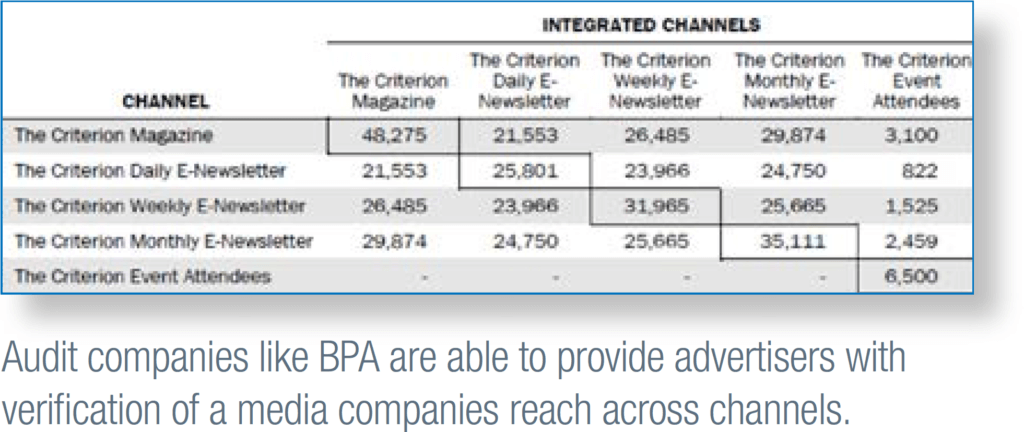 Recently the audit companies also started to audit the publisher’s integrated channel numbers. They verify the stats that publishers present so advertisers can see more specifically what channels the publisher’s audience is using to access their content.
Recently the audit companies also started to audit the publisher’s integrated channel numbers. They verify the stats that publishers present so advertisers can see more specifically what channels the publisher’s audience is using to access their content.
Many publishers have been increasingly trying to push e-versions of their magazines, instead of the printed copies, on their audience — most likely due to cost. However, through direct audience contact and magazine rep interface, AIM’s tele-research staff frequently hears that readers who had been receiving a digital magazine are requesting the print publication back. This is especially true in B2B markets where visual product presentation is important to the audience.
A 2016 article in Entrepreneur Inc.,11 quoted research conducted by Clutch, a business-to-business research firm, that 46% of small businesses surveyed did not have a company website. Huh? When a company has not yet invested in a website of its own, how likely is it for employees to partake in publisher’s electronic initiatives? As much as media companies want to shift to e-media, they have to be careful not to assume that everyone wants a digital publication, thus alienating those who prefer print.
Engagement and Other Opportunities for Success
While it has become difficult to measure and compare both electronic and print media, there are several ways advertisers can try to bring accountability to their advertising programs. There has been a growing cry for sales and marketing teams to “engage” their audiences. Engagement is simply providing ways to get the market to connect more deeply with a brand. The more a print ad or digital communications vehicle can engage the audience, the more opportunity for the advertiser to build a connection. This also provides the advertiser with opportunities to implement some metrics for accountability.
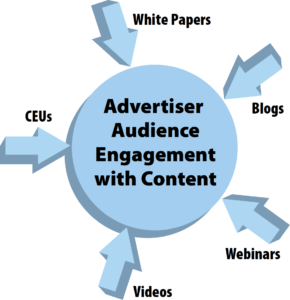 The most successful engagement tactic is often “experiential” events. Experiential marketing provides more of a personal connection between the audience and the brand through participating in personally relevant, credible and memorable encounters.
The most successful engagement tactic is often “experiential” events. Experiential marketing provides more of a personal connection between the audience and the brand through participating in personally relevant, credible and memorable encounters.
Reps often indicate that the marketing tactics most often successful with their digital audience are those communications that require some type of personal engagement by their audience. Blogs, webinars, microsites, videos and white paper downloads were all among the marketing tactics that have been successful.
For example, for one project we were calling over 900 leads from a trade show for a client in order to “feed the CRM.” One of the people we talked with was the manager of energy engineering for a major university located in the Northeast. He told us, “I’m tasked with producing energy across the campus. One of the strategies is replacing such products you’re calling about. It’s a robust program; lots of our buildings. 60-70 projects going on. My department is me, myself and I. We rely on outside contractors. We do surveys, then RFPs.” We obtained a copy of the survey and a list of contractors they used. We documented our conversation, along with the 25 other questions the client wanted answered to feed into the CRM. We called this gentleman back three months later and asked if he had been contacted by the client. “You’re kidding, right?” he said. “Never heard back. But I did hear from their competitor, and right now, they are the manufacturer of choice with our contractors.”
This is not an unusual scenario, because the sales follow has to be firing on all cylinders for accountability in digital or print advertising to work. Unfortunately, it’s all too easy to fill the sales funnel with leads, and then keep filling as they drip out the other end into cyberspace. One of the prospects we talked to said bluntly, “I don’t care where you get the names from. Just get me names. I need to feed these funnels.”
With the explosion of the digital world it is hard to stay up on all the channels marketing and advertising professionals have to help stay engaged with their customers. Does a tweet count to a customer? A prospect? Does a news release appearing in a print or digital outlet count if it leads to something in a couple of months? How do I know the release sparked the conversation? New sources of social and digital channels are emerging daily. Using the “right” channels can be complex and will vary dramatically based on the demographics of your potential audience. Do you use Facebook, Twitter, YouTube, Snapchat, LinkedIn—to name a few? How and what you communicate is critical to your overall customer engagement and measuring the actual success of your communications program.
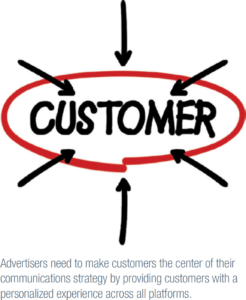 According to a recent Forbes article,12 “Four Trends in Customer Engagement in 2017,” there are some interesting shifts taking place in how companies are engaging their audience. Clearly a greater portion of society is interacting using technology. However, with all the information out in the digital world, brands are getting away from “talking” at their customers and telling their brand story, to asking customers to step forward and tell their story or experience with the brand. In addition, due to information overload with too many facts that contradict themselves, people are focusing on what is emotionally appealing rather than facts, and look for sources they trust. The good news is, people relate to people, not algorithms as some people would have us believe.13 With all the new technology and digital channels available, customers want information when they want it and in the form they need it. It is important for advertisers to stop talking at customers and spend more time listening and engaging customers.
According to a recent Forbes article,12 “Four Trends in Customer Engagement in 2017,” there are some interesting shifts taking place in how companies are engaging their audience. Clearly a greater portion of society is interacting using technology. However, with all the information out in the digital world, brands are getting away from “talking” at their customers and telling their brand story, to asking customers to step forward and tell their story or experience with the brand. In addition, due to information overload with too many facts that contradict themselves, people are focusing on what is emotionally appealing rather than facts, and look for sources they trust. The good news is, people relate to people, not algorithms as some people would have us believe.13 With all the new technology and digital channels available, customers want information when they want it and in the form they need it. It is important for advertisers to stop talking at customers and spend more time listening and engaging customers.
The same is true of publishers and their audiences. Unfortunately, publishers are often more interested in addressing their advertisers as an audience than the audience they control (or try to control). For example, we mentioned that we receive over 1,000 publications each month in our office, each filled with content trying to “engage” readers – or so they claim. One of these publications (transparency alert: we have no affiliation one way or another either directly or indirectly through advertisers with this publication) is ISHN. This is a BPA audited publication, so we know about its circulation. The statement says that the magazine is intended for professionals responsible for the safety within high-hazard industry worksites in manufacturing, construction, health, facilities, and service industries, with editorial providing safety, health & environmental solutions, including OSHA and EPA regulations. It has a circulation of 71,400, 33% of which is digital circulation.
In the April 2017 issue, the cover story is “When work gets intense, Keys for Selecting Welding Helmets.” It was written by Tim Wolski, the manager for Honeywell Safety and Productivity Solutions. It’s a fine article, but is it really engagement with the magazine’s readers? The article starts with statistics about employment of welders in the US (400,000), the risks involved, the safety standards (i.e., OSHA), then goes on to talk about helmet material, shapes, window size and draws a good conclusion. But as far as “engagement” with the audience is concerned, with due respect, so what? This information is readily available on the Internet. If you Google “Risks of welding,” Google delivers over 500,000 results, including one of the top organic SEO results, an 11-page AFSCME’s Welding Hazards paper, more than you’d ever want to know about the risks. If you google “suitable shell material of welding helmets,” Google gives us over 3,000,000 results, including pdfs from some of the major manufacturers of welding helmets. Would the reader of ISHN be “engaged” with this content? Perhaps it would be better if ISHN contacted some of their 71,400 audience and get their take on welding helmets!
On their qualification card, “Welding Safety” is one of the products that the subscriber can check to qualify to receive the magazine. This “count” is not available on the BPA statement, and you’d have to ask for it, but that data set would be terrific to examine, talk to and gain “engagement” information. Of course, Wolski makes great points and is trying to engage the publication’s audience; however, engagement must be with information no one else has, or unique information that can only come from their particular point of view. If you go to the Honeywell Productivity and Workflow Solutions website and search for “welding,” you get three results: an antenna cell data sheet (“Antenna Cells can be mounted with no drilling, cutting or welding”), a case history (“The printers are exposed to grinding, welding, painting, and lubricating everyday.”) and Accessory guide (30 pages, with no reference to welding whatsoever). What’s the point?
Well, Honeywell is an advertiser in that issue, and like a good advertiser, is trying to engage with that audience who needs its products. Unfortunately, the engagement attempt fell short because that audience can get the same information on welding helmets in many other places. True engagement begins and ends with the person you’re engaging. And, if the publisher can’t tell you what his audience is interested in in order TO engage, why waste the time and money when you can do it yourself? We’re quite certain Honeywell has an internal file that goes well beyond the 71,400 circulation of the publication. Besides, there are over 400,000 welders in the US according to the article – and that’s just welders!
In a recent webinar sponsored by Chief Marketer14 and presented by Forrester Research, Inc. and Marketo, it was pointed out marketers have entered a new era of business called the—engagement economy. To be successful, companies need to shift their focus and make the customer the center of their communications strategy. It is critical for advertisers to find ways to engage their customers across all touch points with personalized experiences—be human, helpful and handy.
In the webinar, Forrester Research challenges marketers to think outside the box and use the abundance of data and technology to engage customers across their entire operation and in every stage of the buying process. Companies should become “customer obsessed” by using insight from all data platforms to provide fast, personalized experiences with customers. 1
The problem is that people really don’t relate to numbers – they relate to people. You don’t engage with numbers, you look at them and understand them. 2+2=4 makes you feel normal, but if you see 2+2=5 you get emotional. Something’s wrong. You engage by using data to supplement an emotional response, not make it the main clause.
One example the webinar provided was a program developed by Caterpillar, the CAT 360 Advantage. With this program Caterpillar can embed digital technology into their machinery to provide real time feedback to customers and their channel partners to help optimize safety, productivity and profitability.
You see, it’s all about CONTENT, and therein lies the center of the disruption going on in the B2B media world. Initially, “content” was supplied solely by the publisher, who invited advertisers to hang around the content by placing ads. The now-retired Wally Carlson from S&C Electric Company used to only run spread ads, and when we asked him why, he said, “I don’t want anything interfering with our message with the readers, including the editorial of the magazine.” Wally was ahead of his time, because that is exactly what the Internet and digital tools available today provide every company: the ability to generate content. How does a publisher fit into that equation? Furthermore, what is or is not advertising in that content delivery?
These issues are at the center of the disruption, and these issues MUST be what advertisers confront and strive to measure! Media outlets, too, must confront them, and frankly, re-define their purpose. Because if I, as an advertiser, can touch my target directly — feeding that target MY content, “engaging” that target perhaps daily — what do I need the publisher for?
Today, many publications are offering webinars for continuing education unit (CEU) credit, while others promote live or recorded on demand webinars to their audience. While an advertiser can clearly set up and run a webinar on its own, some advertisers are interested in sponsoring webinars presented by a particular publication, primarily to reach that publication’s target audience.
Some publications claim that if they blast a webinar invitation to 5,000 to 10,000 of their circulation, they could get anywhere from 200 to 800 attendees. Of course, the attendance always depends on the subject and timing, and exact numbers are often not shared or audited.
We have several clients who put on their own webinars or sponsor live events and some can draw hundreds of attendees on their own — from their own lists! Content, as king, becomes the currency in this digital age, and publishers face enormous challenges in not only providing original content, but in convincing advertisers that their content — not the advertiser’s — is more relevant! How DOES that work?
Webinar and events are a great way for advertisers to receive full contact information about the attending professionals. Plus, when the event or webinar is directly related to the product or service the advertiser sells, the advertiser now has a list of people who have expressed an active interest. This not only produces leads for the advertiser, but also a way to evaluate the quality and appropriateness of the publication’s audience.
More and more advertisers are producing short videos as a way to engage their audience. Publishers indicate that advertisers who use product videos in their e-newsletters or as a part of their banner ad were realizing as much as a two-or three-fold increase in the number of clicks as media creative without videos. (Remember, clicks are just that: clicks. You have to know who is clicking!)
Yet here again, YouTube is changing the way video is shown — and indeed, affecting television and cable itself. The disruption of being able to create your own video content, post it, gather a following and continue with your own “programming” has to be making TV executives nervous.
Publications often claim that social media and blogs have been a success with their audience. In addition, many publications are tweeting regularly and have as many as 6,000 or 7,000 followers.
But so what? Generating “followers” isn’t the same as making sales. The battle is about content — relevant content — which fortunately, is and always has been judged by the audiences of the content themselves.
Some publications say that despite how technologically savvy their audience is, many of their reader’s employers prohibit them from visiting social media sites from their work computers. Moreover, some believe that some of the social media sites like Facebook are a “waste” in the B2B media world. This shows that some publishers and advertisers may have a bias against electronic media, but certainly also indicates that there are real roadblocks that can keep some audiences from engaging with publications on a more interactive level.
According to an article by eMarketer,15 many B2B marketers find their social media programs are falling short of expectations. The article indicates while marketers are using social media more, 48% indicate only a medium use. They are finding social media difficult to measure and to find return on their investment. Most indicated that social media fell short of their goal to create greater awareness or increased sales leads. B2B marketers preferred LinkedIn and Twitter over Facebook and YouTube for their social media program.
The success of any advertiser’s or publisher’s social media effort will depend on the relationship and engagement the provider is able to develop with their audience. If advertisers pursue some type of social media relationship with a media outlet, they need to be sure to implement some type of metrics for measuring the success of this type of investment.
Over the years, publishers have learned the importance of defining and protecting the value of social media and electronic offerings as separate, yet integrated pieces of their complete media package. In fact, many publishers have created new electronic hubs for all their magazines because it makes sense to maximize the advertising opportunities. Most media companies have as many or more of their people working on the digital side of the business as they do on print.
Prior to the digital revolution, many publishers offered their digital services as a “freebie” for investing in a print media schedule. This is no longer the case. Media outlets have to charge for their digital service since it has become such a large part of their content offer. To give digital products away, a publisher would severely undermine their worth.
Today it is more important than ever for B2B media companies to demonstrate and verify their connection with their audience. They need to provide proof to advertisers not only of who their audience is; but that their audience is engaged with the content and media platforms they are providing.
Conclusions
Without a way to track and measure advertising, it is very difficult to position the media outlets to maximize the overall success of clients’ advertising programs. Without metrics, how does an advertiser know how its media buy in one media outlet fared compared to another? How do marketers know what works and what doesn’t?
 AIM has found through the years of analyzing and talking with readers of publications, that some publications have a relationship with their audience and some do not. AIM has developed and tried to measure what we call a publication’s “affinity” with their audience. The affinity is the strength of the publication’s relationship (or engagement) with their audience. There are publications that have affinity, and those that don’t. When we talk with a reader of a specific publication and they can express clearly, without a doubt where they saw, read and responded to an ad — that is a high level of affinity. When a reader is not sure or names several publications where they “may” have seen an ad, that is low affinity.
AIM has found through the years of analyzing and talking with readers of publications, that some publications have a relationship with their audience and some do not. AIM has developed and tried to measure what we call a publication’s “affinity” with their audience. The affinity is the strength of the publication’s relationship (or engagement) with their audience. There are publications that have affinity, and those that don’t. When we talk with a reader of a specific publication and they can express clearly, without a doubt where they saw, read and responded to an ad — that is a high level of affinity. When a reader is not sure or names several publications where they “may” have seen an ad, that is low affinity.
The problem today, however, is the abundance of outlets with affinity. In the past, you had a few in each market. For example, in the industrial marketplace, you had five major publications, which turned into as many digital outlets once the Internet kicked in. Today, there are over 100 of these outlets if you include the blogger influencers, and also include the individuals within these media outlets who have their own following! As this splinters, the advertiser is strapped with trying to find out how his $1 should be spent – and where is its maximum value. And the only way to measure that is on the back end – with the results that the spend generates. It will not be what a program tells you is the “response rate” and it will not be how many more clicks you receive, or posts you post. It will be in the number of sales you eventually produce through the integrated marketing effort.
Despite the interest in engagement through social media, webinars, electronic and other channels, many publications have lost or are destroying their affinity because of this splintering. As the quality of their circulations decrease or is disrupted, channels of accountability are eliminated, digital communications stumble to provide accountability, and audience affinity decreases. How can readers happily maintain a relationship with an audience when they daily receive five or more e-mails from different publications in the same industry? One publication becomes the same as the next. Commoditizing occurs. Some readers become so swamped with communications that they reduce their engagement.
 Media outlets and publishers need to be forced — by advertisers — to maintain the quality of their circulation. But so do the advertisers. It’s not enough to “fill the funnel.” It’s about knowing what you put in, and what you get out. While advertisers are exploring a combination of print and electronic media ventures, they cannot forget to demand accountability for both their print and digital purchases.
Media outlets and publishers need to be forced — by advertisers — to maintain the quality of their circulation. But so do the advertisers. It’s not enough to “fill the funnel.” It’s about knowing what you put in, and what you get out. While advertisers are exploring a combination of print and electronic media ventures, they cannot forget to demand accountability for both their print and digital purchases.
If advertisers don’t hold media outlets accountable for their circulations, and they fail to demand tools to measure and evaluate the success of their ad campaigns, then they are throwing their money away.
It is access to a qualified target audience, as well as the relationship the publication has with readers, that advertisers are buying from publications.
If a media outlet can’t prove that it can provide access to a desired audience, and if it hasn’t developed or maintained a good relationship with their audience, what is an advertiser buying?
That’s a good question. Hopefully, we shed some light on the answer.
Getting seen, read and then inquired upon has been the path to purchase since sales began. The disruption going on today in communications is re-shaping not only that channel, but the methods of getting seen, read and then inquired upon. In a recent Advertising Age article, Rebecca Lieb wrote: “Content won’t replace advertising, will it? Of course not.” She’s wrong. Content IS advertising, and advertising IS content. It always has been. It’s simply the delivery of that content that is being changed, and for the better!
Please let us know what you think of our white paper.
Thank you for your time.
- Statista is one of the leading statistics companies on the internet. In fact, according to another study by eMarketer, digital advertising surpassed TV ads in 2016 for the first time.
- “Plummeting Newspaper Ad Revenue Sparks New Wave of Changes,” GroupM, the ad-buying firm owned by WPP PLC, as reported in WSJ, October 20, 2016.
- “P&G’s Marc Pritchard Doubles Down on Demands of Digital Ad Giants,” Alexandra Bruell, WSJ, March 2, 2017.
- “How ad blocking played out in 2016,” Lucinda Southern, post on Digiday, December 27, 2016.
- Email Marketing Benchmarks, MailChimp, updated February 2017.
- “The big data canary in the coal mine,” Patrick Gray, TechRepublic, January 23, 2014.
- “Five Business Intelligence Predictions For 2014,” Prakash Nanduri, CEO of Paxata, Forbes, January 2, 2014.
- “Education Is Still the Problem for Big Data,” eMarketer, December 31, 2013.
- “Big data 2.0 New business strategies from big data,” Deloitte University Press, January 31, 2013.
- Ad Blocking Poses a Growing Challenge to Media Companies, Lauren Shaw, American Journalism Review.
- “It’s 2016 But Almost Half of Small Businesses Still Don’t Have a Website,” Entrepreneur, Inc. February 19, 2016.
- “Four Trends in Customer Engagement in 2017,” Rawn Shah, Contributor, Forbes, December 12/2016. The article highlights the Fjord Trends for 2017. Fjord is a design and innovation consultancy unit of Accenture Interactive.
- Yuval Harai, author of Sapiens, keeps telling us that algorithms will be our new “go to” for answers. Our response? Who wrote the algorithm? This is a deep, philosophical discussion, but it pertains to advertising in the sense of, “Who do you believe?” You can grow impressions from 900 a day to 73,000 a day, but so what? Who is being impressed?
- “Marketing in the Engagement Economy,” 2016 Chief Marketer, webinar presented by Forrester Research, Inc & Marketo.
- “Social Media Falls Short of Expectations for B2B Marketers,” eMarketer, January 19,2017 quotes two social media research surveys by Bizible and Regalix, digital technology and business information providers.
